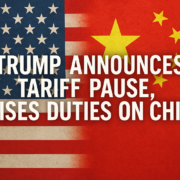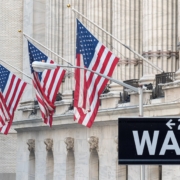Federal Layoffs Trigger Consumer Anxiety, Threatening U.S. Economic Growth
The Department of Government Efficiency’s latest layoffs—a bloodbath dressed up in bureaucratic double-speak—have landed like a gut punch to consumer confidence, stoking fresh fears of economic turmoil. While these cuts have yet to show up in the unemployment rate, their psychological impact is already warping the financial landscape. Markets are jittery, economists are slashing forecasts, and regular people—the ones who actually power the economy—are tightening their wallets in anticipation of more bad news.
Economic Experts Warn: The Slow-Motion Crash Has Begun
Economist Nancy Lazar isn’t mincing words: the U.S. economy is lurching toward contraction, dragged down by a record trade deficit and faltering consumer spending. The Federal Reserve Bank of Atlanta, typically allergic to pessimism, has slashed its GDPNow forecast. The math is grim—GDP growth projections have been cut from 2.1% to 1.2%, a free fall that economists say could turn into an outright contraction if consumer spending keeps deteriorating.
If that happens, don’t expect the suits in Washington to be caught off guard. They saw this coming and plowed ahead anyway.
Federal Layoffs Ripple Through Local Economies Like a Slow-Moving Disaster
Sure, the layoffs are happening at the federal level, but that doesn’t mean their impact stops at the doors of government buildings. In states like Maryland, Virginia, and California, where federal workers make up a hefty chunk of the local economy, small businesses are already seeing the fallout. Fewer customers, shrinking sales, and an air of uncertainty that’s bad for business.
If history is any guide, these layoffs won’t just hurt government employees. They’ll drag entire communities down with them, gutting tax revenue, slashing disposable income, and pushing businesses to cut jobs of their own. A so-called “leaner government” is great—until it leaves behind an economic crater.
A Trade Deficit Spiraling Out of Control
Just when the economy could use a break, the U.S. trade deficit just exploded to a record-breaking $89.2 billion in January. Why? Because businesses, knowing that tariffs are about to go through the roof, are panic-buying imports like doomsday preppers hoarding canned food. This artificial spike in trade activity won’t last, and when the inevitable cooldown comes, the numbers will look even worse.
And that’s before American consumers start feeling the pinch of those price hikes. Inflation is already testing wallets—throw in tariffs, and household budgets could snap altogether.
Consumer Spending Craters as People Brace for the Worst
Personal spending has always been the backbone of the U.S. economy. But right now? It’s looking more like a stress fracture. Inflation is relentless, layoffs are looming, and economic uncertainty is turning big purchases into a no-go.
Retail sales dropped 0.7% last month, a canary-in-the-coal-mine warning that consumers are bracing for impact. And let’s be clear: when people stop spending, businesses start cutting. That means more layoffs, more insecurity, and a feedback loop of economic misery.
The Psychological Hammer Blow of Mass Federal Layoffs
Beyond the hard numbers, there’s an invisible but equally destructive force at play—fear. Fear of job loss, fear of financial instability, fear that whatever is coming next will be worse than what’s already here. Consumer confidence just cratered by 12%, which means millions of Americans are looking at their finances and choosing to hunker down rather than spend. That kind of sentiment can push a recession from “possible” to “inevitable” real fast.
Wall Street Shrugs While Main Street Bleeds
Of course, if you ask Wall Street, everything is fine. Stocks are still floating because, to the suits, layoffs just mean “greater efficiency.” Corporate America loves it when costs are slashed, even when those cuts come at the expense of regular people.
But take a walk down Main Street, and it’s a different story. People aren’t spending, businesses are hurting, and job security is becoming an endangered species. Wall Street’s celebrations don’t mean much when the average worker is wondering how they’ll cover their next mortgage payment.
Slashing the Federal Workforce Might Look Good on Paper—Until the Bills Come Due
The talking points are predictable: “Government should run like a business.” “We need to cut waste.” But history tells a different story—one where massive government layoffs don’t lead to efficiency, but to a shrinking economy, lost services, and increased hardship for working families. Slashing the workforce doesn’t just save money; it removes buying power from the economy and drags down long-term growth.
The Clock is Ticking on the U.S. Economy
As layoffs ripple outward, the bigger question is: how much damage will this cause before someone steps in? Every indicator—from shrinking consumer spending to rising trade deficits—points to an economy heading toward a bruising slowdown. If nothing changes, that “soft landing” the Fed keeps talking about will look more like a hard crash.
The Bottom Line: Time to Wake Up
This isn’t just another economic cycle. This is a self-inflicted wound, driven by policy decisions that prioritize balance sheets over people’s livelihoods. Policymakers need to step in—fast.
Call to Action:
- Policymakers: Wake up. Stimulus, targeted job programs, or actual economic leadership are needed before this spirals further.
- Businesses: Adapt now. Focus on essential goods and services that people will still buy even in an economic downturn.
- Consumers: Get informed. Make financial decisions based on long-term stability, and don’t let fear dictate your entire spending strategy.
This isn’t just theory—it’s happening now. The only question is whether leaders will react before the damage becomes irreversible.









Leave a Reply
Want to join the discussion?Feel free to contribute!